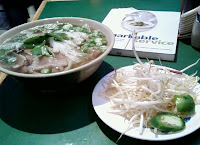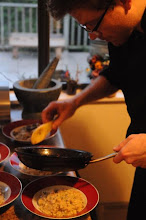 I've just spent nearly 3 hours in a classroom being bombarded by stories of places I'll never see, magazines I'll never be published in, and examples of writing that I'll never live up to. My sinuses are clogged, my muscles ache, and I swear my forehead is being cleft by an invisible chisel. I'm not dressed for the frost that has grown on the asphalt or the sight of my breath as I shuffle my way to the 99 B-Line. The only proof of grace in this unholy night is the 24hr Pho place between the Cambie Street bus stop and the Canada Line back to the North Shore.
I've just spent nearly 3 hours in a classroom being bombarded by stories of places I'll never see, magazines I'll never be published in, and examples of writing that I'll never live up to. My sinuses are clogged, my muscles ache, and I swear my forehead is being cleft by an invisible chisel. I'm not dressed for the frost that has grown on the asphalt or the sight of my breath as I shuffle my way to the 99 B-Line. The only proof of grace in this unholy night is the 24hr Pho place between the Cambie Street bus stop and the Canada Line back to the North Shore. Kim Penh Xe Lua is probably my single favorite place in this sprawling metropolis. If I'm to follow Don Genova's guidelines on “good food and travel writing,” I should be acutely in tune with the sights, sounds, smells, and people I notice upon entering this little hole in the wall... but all I can think about is a large #16. That's the adventurer's bowl: with brisket, tripe, tendon, and fatty flank. That's the medicine. That's what a Cambodian grandmother would give me if I had the sniffles. That's a healing bowl of steaming restorative and spices, with a liberal helping of hearty offal.
This is not food for the faint of heart, the germophobe, or the Eurocentric elite. This is salt-of-the-earth food, stick to your ribs food, put hair on your chest food. Just what I need tonight. A good writer would be aware and expressive of the subtly scented and slightly sweet broth of beef and allspice. A good writer might waft the aroma and relish in its simple perfection, and take small aerated sips while losing himself in the experience of layers of flavor washing over his finely tuned palate. I'm lucky I remembered to pull out my phone to snap a quick shot before I inhaled this huge portion in one hurried gulp.
It seriously took me about 2 minutes to finish eating this massive bowl of soup. Everything was gone, the large pile of juicy bean sprouts, the fresh sprigs of Thai basil, the segments of lime (yes, I ate the pulp too), and the slices of jalapeno. For even more spice I squeezed a good tablespoon of sriracha sauce from the bottle on the table in there, too. As I slurped, I sweated. And sniffed. And snorted. I coughed up all kinds of gnarly phlegm. This $7 bowl of street food was exorcising my demons.
This bowl of soup is transcendent. Not a silver shrimp forks and folded napkins kind of sublime, I'm talking about a working all day in a rainy rice field and need to regain your constitution kind of fulfillment. It's a shame that, often, those who consider themselves gastronomes can become so bloody pretentious as to overlook these more visceral food experiences. Food isn't necessarily about immaculate service and ornate table settings. It doesn't have to always be about perfectly dressed salads and filament-thin chiffonades, does it? Are we not simply animals, after all?








